From Staubach to Dak: An Oral History of the Cowboys’ Quarterbacks

From The Cowboys QBs, a special issue of Sports Illustrated. To order, click here.
Don Meredith lit his cigar and took a puff as he nodded along to his coach’s lecture. Tom Landry stood facing the chalkboard, presiding over one last quarterbacks meeting before the 1968 Hall of Fame game in Canton, Ohio. Landry allowed his players to smoke inside meeting rooms, and in training camp that year Meredith had persuaded many of his teammates to trade in their cigarettes for cigars. Meredith had recently perfected the art of twirling the cigar around in his fingers and enjoyed showing off his tricks, especially during meetings that dragged on, like this one. “He twirled it like guys used to do with silver dollars as magicians,” recalls Meredith’s backup, Craig Morton.
Meredith tapped Morton to get his attention. “Hey, Curly, watch this one!”
Landry turned and barked, “Don, are you listening to me?”
Flustered, Meredith quickly put the cigar back in his mouth. Too late, he realized he’d accidentally inserted the wrong end. Meredith violently spit the cigar out. It hit the chalkboard and landed next to Landry. “There were ashes everywhere, ashes over Coach Landry, as Meredith is spitting and choking,” Morton remembers.
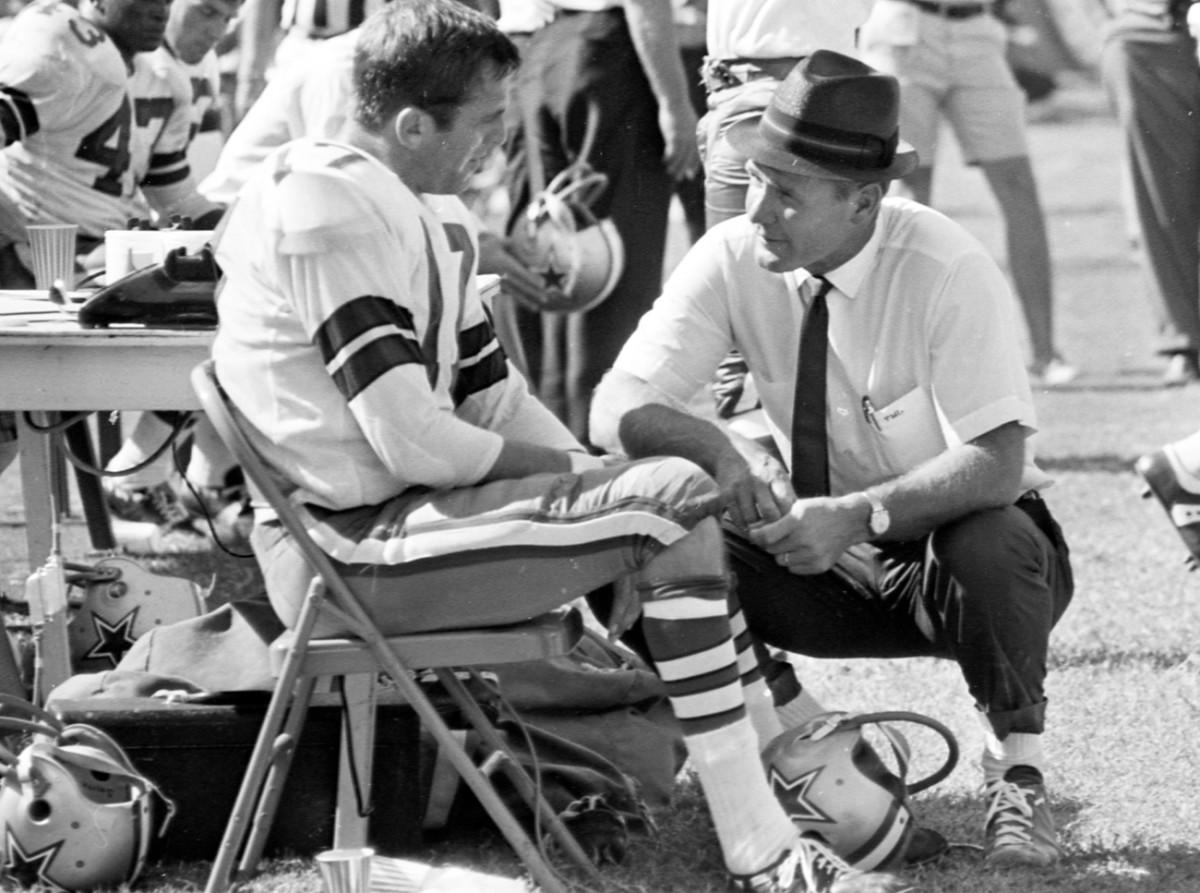
Meredith leaned over and stuck his tongue out to reveal a big, red blister, sending Morton into a fit of laughter. Landry stood motionless, unamused. “Craig,” he said, “would you like to leave the room to try to control yourself?”
Even if they weren’t always so behind closed doors, make no mistake: Dallas Cowboys quarterbacks have always been among the coolest cats in sports. Meredith was one of the first in a line of Cowboys quarterbacks who turned the position into an iconic role in sports. In total, 40 men have started a game for Dallas, some more memorably than others.
What’s it like to be the leading man on America’s Team? Hear it from 17 men who’ve held the job. It’s not just about the fame and fortune. Close, but no cigar.
BECOMING AMERICA’S TEAM
Cowboys quarterbacks began to capture the nation’s attention during the days of Dandy Don and Next Year’s Champions: Don Meredith’s Cowboys made the playoffs three times and advanced to two NFL championship games, but he never led the team to the Super Bowl. Meredith retired after the 1968 season, leaving the job to Craig Morton. The Cowboys won the ’70 conference title with Morton at the helm but lost Super Bowl V, a defeat that paved the way for one of the most well-known quarterback controversies in NFL history. Morton vs. Staubach reached its peak in Week 7 in ’71, when Landry famously alternated the two quarterbacks for each play in a game at Chicago.
CRAIG MORTON (1965-74): When Don Meredith was playing, they were booing him like mad, they were saying, We want Morton! We want Morton! So I went over to him, and I said, “I’m sorry, Don, I hate hearing this.” He said, “Hey, don’t worry about it, Curly. It’s going to happen to you.”
ROGER STAUBACH (1969-79): Coach Landry announces in ’71 at the start of the season, “We have two starting quarterbacks.” That was a shocker to everybody.
MORTON: Landry had an unbelievable explanation for alternating us. He said, you’ll be right next to me, so when the next play starts, we’ll talk about it before you go in. First of all, he doesn’t have a clue what the next play is going to be, because he doesn’t know the yard and distance. And then you don’t have any time to talk about it, because you only have 25 or 30 seconds to get the play off. You’re running in there as fast as you can, breathing hard, and then you run out. It was so dumb.
STAUBACH: I thought maybe he had a stroke or something.
MORTON: It was not a good decision. I would say that was probably his worst moment.
STAUBACH: We lost to the Bears during the season, so I figured that Coach Landry was going to figure out he better get a starting quarterback. Everybody was divided. The team was probably split in half as to who should be starting, and that wasn’t good. You needed a team leader at quarterback.
MORTON: Coach Landry called me at my house one night about 10:30. He says, “Craig, can you come over?” I knew it was about time that he needed to make a decision. So I come over, and I went into his office, and he looked at me and said, “Craig, I’ve got this feeling, I’m going with Roger. Thanks for coming over.” And that was it. He did that same thing the next year and the next.
STAUBACH: Landry said, “This was a tough decision, but we’ve got to commit to one quarterback. You’re going to be the starting quarterback.” That’s all he said.
MORTON: He wasn’t real free with his feelings.
Tired of taking a back seat in Dallas, Morton asked for a trade during the 1974 season. The Cowboys dealt him to the struggling Giants. After a short stint with the Giants, Morton eventually revived his career with the Broncos. Staubach’s taking over as starting quarterback was a pivotal moment in the Cowboys’ history. The man who would go on to win two Super Bowls during his career in Dallas, make the Pro Bowl six times and cement himself as a Dallas icon was one of the most important players in the franchise’s history. And from very early on, his teammates knew he was a different kind of beast.
JERRY RHOME (1965-68): I remember Staubach coming in. We were sitting there working out: me, Meredith, Craig Morton. Staubach was still in the Navy, and instead of going home, he comes to Cowboys training camp. It’s just starting, so we’re out there in shorts, taking it easy. And here comes Roger Staubach; he’s fully dressed, he’s got his helmet, shoulder pads, the whole works, and I turn around to Meredith and say, “We’re in trouble, man.”
BABE LAUFENBERG (1989-90): For everybody that comes through here, Roger is the gold standard. He wins the Heisman, graduates from the Naval Academy, serves the country, comes back, wins the Super Bowl, wins another, goes on to have a multimillion-dollar international real estate company, and he’s in the Hall of Fame. I said to Roger one day, Roger, do you ever get tired of accomplishing things?
STAUBACH: The proudest moment I had was when I was in the locker room with all the guys that had said they were next year’s champions, the Bob Lillys and the Mel Renfros and the Cornell Greens and all the guys that were there when I was still in the service, watching the Cowboys when they played in the Ice Bowl [in December 1967]. I was their quarterback in the first Super Bowl that we won [Super Bowl VI, in January 1972], and it took all the pressure off us. Dallas was a winning team, it was a good team, and Meredith had built it to a good team. But until you win that Super Bowl, you are just next year’s champions; you can’t win the big game.
As the Cowboys grew in prominence with their Super Bowl VI win, Landry’s profile grew as well. The future Hall of Fame coach’s steady guidance of his quarterbacks over 29 seasons in Dallas would play a huge role in the success of the franchise.
STAUBACH: They asked Walt Garrison one time, did you ever see Coach Landry smile? And he said, “No, but I have only been here nine years.” There is the picture of Coach Landry being carried off the field with a big smile on his face.
MORTON: When Landry laughed, everybody just laughed because it didn’t happen that often.
DANNY WHITE (1976-88): I wouldn’t call it fear; I don’t know if we were afraid of him—we were afraid to disappoint him. This is an amazing statement, but in 13 years I never heard him raise his voice, because he didn’t have to. He did one time, and I saw pictures of it. He was yelling at me when I audibled on fourth down against the Redskins and wasn’t supposed to.
STEVE PELLUER (1984-88): It seemed like even the coaches were a little intimidated by him. I was intimidated, especially since I was a young player. He had a stern look about him and didn’t smile a whole lot.
STAUBACH: In practice we put in a few new goal-line plays, and Landry always liked to step in there and say, “Here’s how you do it.” I happened to run this goal-line play, and he said, “No, you need to give it a stronger fake to the fullback.” It was kind of a fake inside and then rolling to the right, so he said, “Here, give it to me.” He had a bad knee, so he faked to the fullback, and he started rolling to the right, and he started limping to the right with his knee. So I got back in there and ran, and I started limping to the right. Everybody got a kick out of it except Coach. When you were on the field, he was serious about everything.
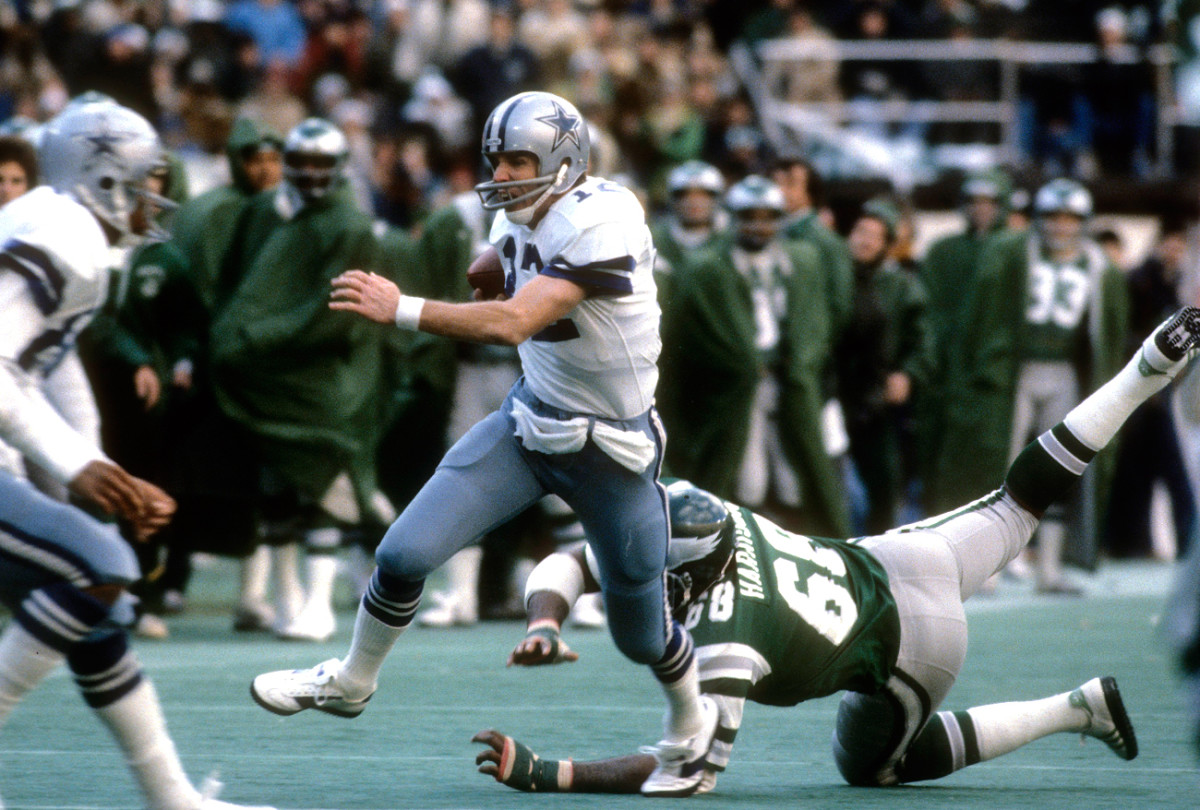
WHITE: If you messed up, he would just look at you and roll his eyes. And that’s all he had to do. Roll his eyes at you, like, Oh brother, what was that? It was like sticking a hundred daggers right through your heart. It was the most painful thing. Fine me, make me run a hundred laps, but don’t give me that look, whatever you do.
STAUBACH: I was on the sideline one time, and I’m waiting for the play, and Landry has his arms folded. He’s rolling his eyes, and he’s looking up through the hole in the roof. He finally looks down and gives me the play. So I said, “Hey, Coach, I was always wondering where you got those plays from.” He made it look like he was God’s son there on the sideline, looking up to get the play. All the assistant coaches started laughing.
WHITE: Even when the crowd was booing and they were writing bad things about me in the paper, I knew that Coach Landry was in my corner. I always knew that, so when he benched me in 1984, that was like the worst thing that could have happened, and it destroyed my spirit for the whole year. Even when I came back as a starter, it became a job for me, and the passion was gone. I was devastated. Anybody else could have said anything they wanted to, and it wouldn’t have hurt me one bit. But when Coach Landry said something, it meant the world to me.
STAUBACH: He really had this tremendous ability to focus and concentrate. He was an industrial engineer, so his preparation and his thinking didn’t have a lot of emotion.
Clint Longley is a fascinating footnote in the annals of Cowboys quarterbacks. A backup to Staubach for two seasons, the Mad Bomber is known for his performance off the bench as a rookie in the 1974 Thanksgiving Day game against the Redskins. With the Cowboys trailing 23-17 and with only 35 seconds left and no timeouts, Longley hit Drew Pearson down the middle for a 50-yard touchdown, good for a 24-23 comeback victory. Though Longley never challenged Staubach for his starting job, he did end up fighting him during training camp in ’76.
WHITE: Well, I wouldn’t use the word fascinating. I would say the guy was crazy. He hunted rattlesnakes for his hobby.
STAUBACH: I liked Clint. He sat with me on the plane going to games, and he was my backup for two years. There was something about Clint that was awfully good. He didn’t mind being the backup or at least he didn’t act like it. Then Danny came, and the mood changed.
WHITE: Roger was one of the first guys to welcome me [in 1976], and we started working out together every day, and Clint would never come when we were there. He was upset because all of a sudden I was a threat to his job.
STAUBACH: He really didn’t speak to us by the time we were in training camp. It wasn’t hunky-dory.
WHITE: Drew Pearson ran a pass route, and he slipped and fell, and Clint went ahead and threw the ball anyway, and it hit Drew in the head. Roger turned around to Clint and said something like, Oh, way to go, Rabbit Tooth. Because Clint had buck teeth, and he looked like Bugs Bunny. So Clint challenged Roger to a fight.
STAUBACH: We walked off to the side of the field and ...
WHITE: They say to me, “Danny, you keep Coach Reeves occupied so he doesn’t see us.” That was my job. I turn and look around, and Roger is over there, down on his knees just pounding away at Clint. I thought he was going to kill Clint! Dan Reeves saw it, and he went running over there and stopped it.
STAUBACH: Longley actually told [cornerback] Mel Renfro, he said something like, I need to get out of here, and the way I need to get out of here is to hit Staubach. Then he wanted to get into a second fight a few days later before practice. I am literally putting on my shoulder pads in the locker room and—
WHITE: Clint walks up behind Staubach and just cold-cocks him. I mean, you have to be a little bit crazy. There has to be something wrong with you to do something like that! And then he takes off running with Roger chasing him, blood running down his face.
STAUBACH: That was the last I saw of him. I feel bad now. At the time I was really upset, and I wanted to get him, but looking back on it, the fact is that he lost his job to Danny White, and he changed his attitude. He didn’t want to be a third-team QB, but he was a Cowboys QB and a good one there for a while.
WHITE: Never in the history of football has anybody gotten more out of one pass than Clint Longley. Clint was fascinating, if you want to call him that, but I just think there was one little screw that was not attached.
Staubach retired after the 1979 season, citing concerns about his long-term health and the 20 concussions he’d had during his career. White had big shoes to fill, but he filled them admirably. White took the Cowboys to three consecutive NFC championship games but lost all three of them. Although he put up impressive statistics, White is arguably one of the most underappreciated quarterbacks in Dallas history because he never led the team to a Super Bowl.
WHITE: Becoming the starter was almost overwhelming. I just wanted to go home. I was so tired of answering questions and talking to people. And everybody had to have their answer to the same question. It just got so old. What does it feel like filling Roger Staubach’s shoes? I must have been asked that question a million times. I wanted to say, Look I’ve already answered that question, can we move on to something else? I started and finished five full seasons, and we were in the playoffs all five years. If you just go by that, then maybe I am underrated.
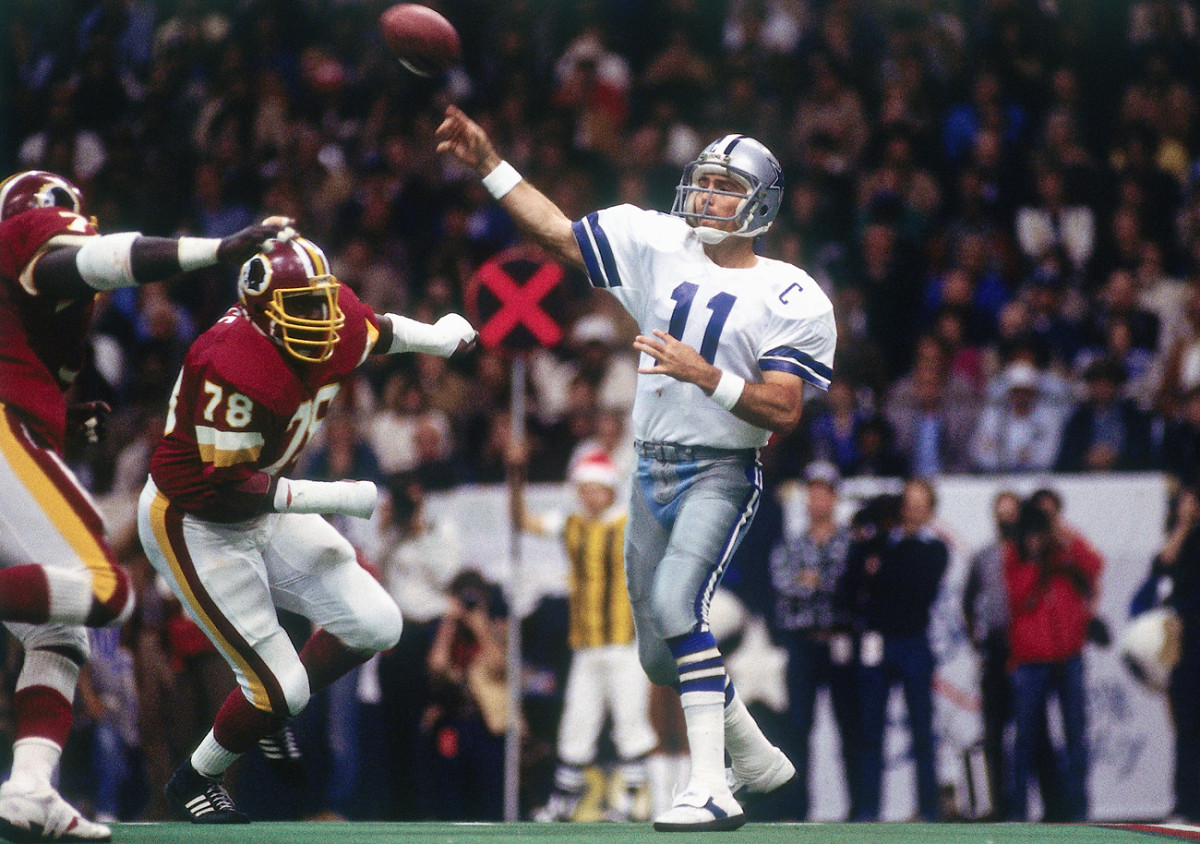
LAUFENBERG: Danny White had a great NFL career. If you told me my brother, my son, my nephew would have the career that Danny had, I would be so proud of them. But somehow you are looked at as having failed. Maybe you’re not a failure, but having failed, I’m sure it’s a tough thing to deal with.
WHITE: I’m over [not leading the team to a Super Bowl]; I don’t think about it, it doesn’t bother me. There are a lot of great quarterbacks that didn’t make it to the Super Bowl. I played in two Super Bowls, so it’s not like I never was in one, and I actually played quarterback in the first because Roger broke his finger, so I played in a Super Bowl, and I was a punter in both of them. I just never took a team to a Super Bowl, and if I could do it all over again and change one thing, it would be that. But it’s not something I sit around and think about.
THE NEW ERA
1989: A year of big change. White retired. Jerry Jones bought the team and promptly fired Landry, the coach since the team’s inception, and his entire staff. New coach Jimmy Johnson and a new regime drafted Troy Aikman to lead a team coming off a 3-13 season, the worst in team history. Before it could become one of the most star-studded teams in all of sports—with a core of Aikman, Emmitt Smith, Michael Irvin and Deion Sanders—the franchise first had to hit rock-bottom.
TROY AIKMAN (1989-2000): When I got there in ’89, I didn’t feel any historical pressure. It wasn’t like, Wow, this is a standard I have to uphold. There are people who would compare playing quarterback for the Dallas Cowboys to playing centerfield for the Yankees, but I don’t know about that. It certainly didn’t feel that way when I got there. We were not a good team—not at all.
LAUFENBERG: That season was almost like one big training camp, one big audition. It was such a transitional period because a lot of the veteran players that had been here were gone that year. From Hall of Famer Randy White to Danny White to Coach Landry and his staff. Every Monday we probably had five new players in. Five guys would get released, and five more would be in the next week. Jimmy clearly had a plan with what he wanted to do and how he was going to go about it. You got to Sunday, and you said, Oh that’s right, we have a game don’t we?
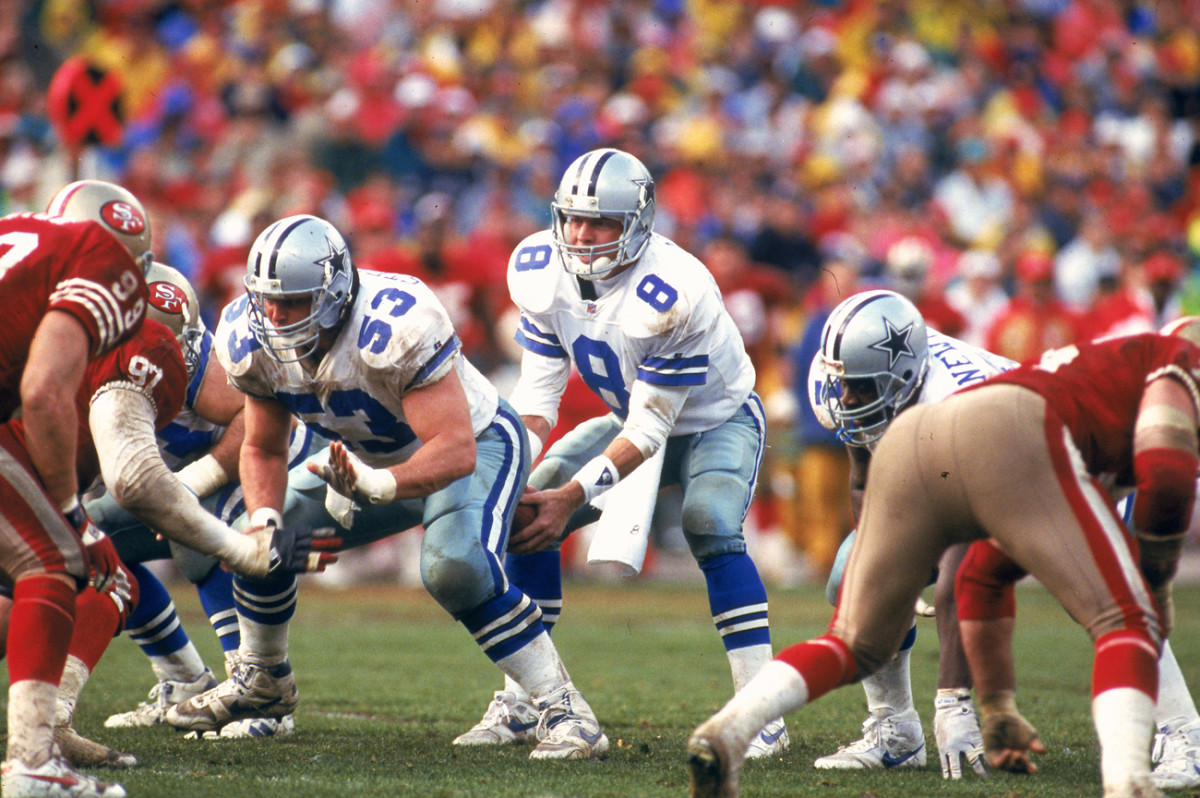
STAUBACH: I’ve always been a big Aikman fan. Even when Aikman was a rookie and had a tough year, he never complained and he never blamed anybody. I could see he had the talent. They just needed to get some things and some people around him.
LAUFENBERG: Troy went 0-11 his rookie year. It was brutal. We won one game in 1989, and Steve Walsh was actually the guy who won that game. Troy actually didn’t win any. The expectations weren’t there like they were for that team in the ’90s, when they started winning Super Bowls. I remember looking up and he was 0-11, and he said, “What’s it take to win a game in this league? I just want to win a game.”
AIKMAN: The realization for me after we won our first Super Bowl was that winning wasn’t going to be as enjoyable as it once was. The bar was raised. Championships were all that mattered. Championships were expected from that point on. There’s no doubt the climb from the bottom of the league was a fun ride. Then it was just different.
LAUFENBERG: It was like the Bulls when they had Jordan and they become something other than an athletic team—they become rock stars. The ’90s Cowboys had it. They had big personalities. Shoot, the offensive linemen here were famous. There was the Kitchen [Nate Newton] and all these guys that went by one name: Michael, Emmitt, Deion.
WADE WILSON (1995-97): Anytime we went to the hotel, on the road or at home, we would never go through the lobby; we would park in the back and go through the service elevators because there would be so many people out there. You go park and it was fenced off, and there would be two or three thousand fans out there just begging for an autograph. To Troy’s credit his focus was unbelievable. He never got caught up in the fame.
LAUFENBERG: I could go somewhere [in public], and Troy couldn’t. That was a bad relationship. The only thing I could really compare it to would be the Rolling Stones, where it’s just a frenzy. If you meet Jack Nicklaus, I think there is an appreciation for what he’s done and who he is, but it’s not a frenzy.
JASON GARRETT (1993-99): A lot of those high-profile guys would compete with each other to see who was going to be the last one out of the hotel. They were playing chicken with the departure time, coming right down to the wire with it, to see who would be the last one out. They had hats and hatboxes, and all the different things that went with it. There were a lot of great personalities on that team.
AIKMAN: This may sound weird, nonsensical, but when I look back on my career, the vision I have is from our Super Bowl at the Rose Bowl [in January 1993]. I threw a touchdown pass to Alvin Harper to put us up by a lot in the fourth quarter. Now we knew we were going to win the game. No way they’re going to come back. I go to the sidelines after that touchdown, and I see all the guys who’d been through so much to get us to that point. I see Kevin Gogan, I see Ken Norton Jr., I see Jimmy Johnson, all smiling, all so happy, like this was the pinnacle. When I think of my career, when I think of my 12 years, that’s what I see. That moment.
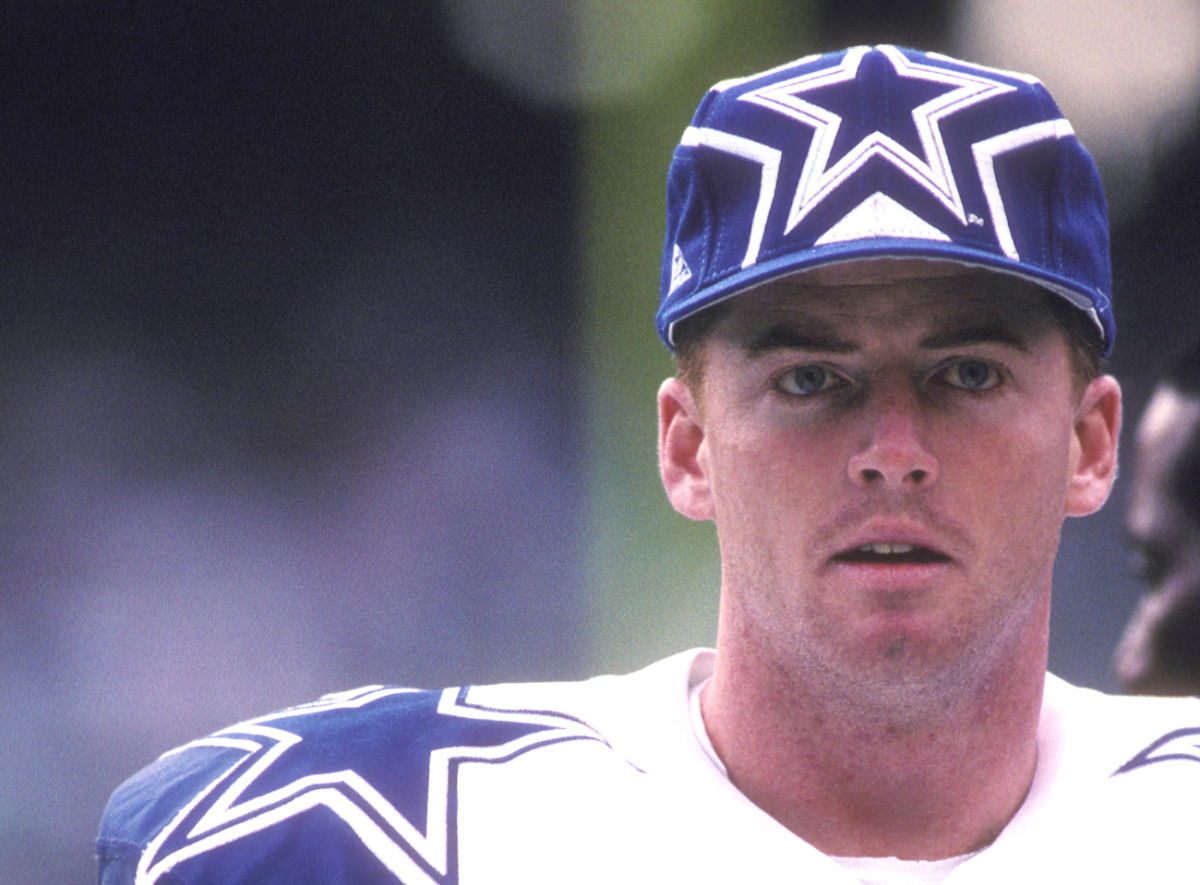
GARRETT: I always say this, but if Troy walks into a room, you say that’s exactly what an NFL quarterback should look like: He’s 6’4”, 222 pounds, he’s got long arms, he’s got big hands. He throws the ball as well as any quarterback I have ever been around, quick, compact delivery, has as much arm strength as anybody. His accuracy in all parts of the field was off the chart. There would be days and weeks that went by where he wouldn’t throw incomplete passes.
WILSON: Troy was the most detailed person I’ve ever been around in my life. I got there in ’95, and he’s already been there seven years and won two Super Bowls. Ernie Zampese, the offensive coordinator, is installing plays, and Troy is taking notes with six different colored pens! Good Lord, this is the same play we ran 12 weeks ago! He’s like, This color is my height, this is my sight, this is my read. Six different colors! I’m thinking, I got this, but maybe I should be doing that as well? He was seven years in and still doing the exact same thing.
EMPIRE FOR A NEW CENTURY
Aikman retired following the 2000 season, and the Cowboys entered a transition period as they struggled to find a stable successor, cycling through eight starting quarterbacks in six years. By the start of the new decade, however, Jerry Jones had firmly established himself as the league’s most visible owner, growing the franchise into one of the biggest empires in sports. And in ’09, Texas Stadium was replaced by AT&T Stadium, which gave the Cowboys—and their quarterbacks—the grandest stage in the NFL.
QUINCY CARTER (2001-03): [Jerry Jones’s] attentiveness to every facet of that organization was always amazing to me. I’m not feeding you some b.s.—it ain’t nothing that goes through that organization that that man doesn’t know about.
GARRETT: He is not this guy standing up in the tower looking down on everybody.
CARTER (released in 2004 for reportedly failing a drug test): He was heavily involved with getting me counselors that could help me with some of my issues off the field and behind the scenes before it came up through the league. Who wants to admit they are a [marijuana] addict at 22 years old? Who wants to say you have a problem? And then who wants to go tell strangers your business when you may think they might be going to tell your employer? I had all that pressure on me, so it was like, Oh, hell no. I can’t admit to this. I can’t ... He did some things extra that he wasn’t doing for others; well, I don’t know about others, but I know what he was trying to do for me. From Day One. I just want to look him in his eyes and tell him thank you for what he did for me.
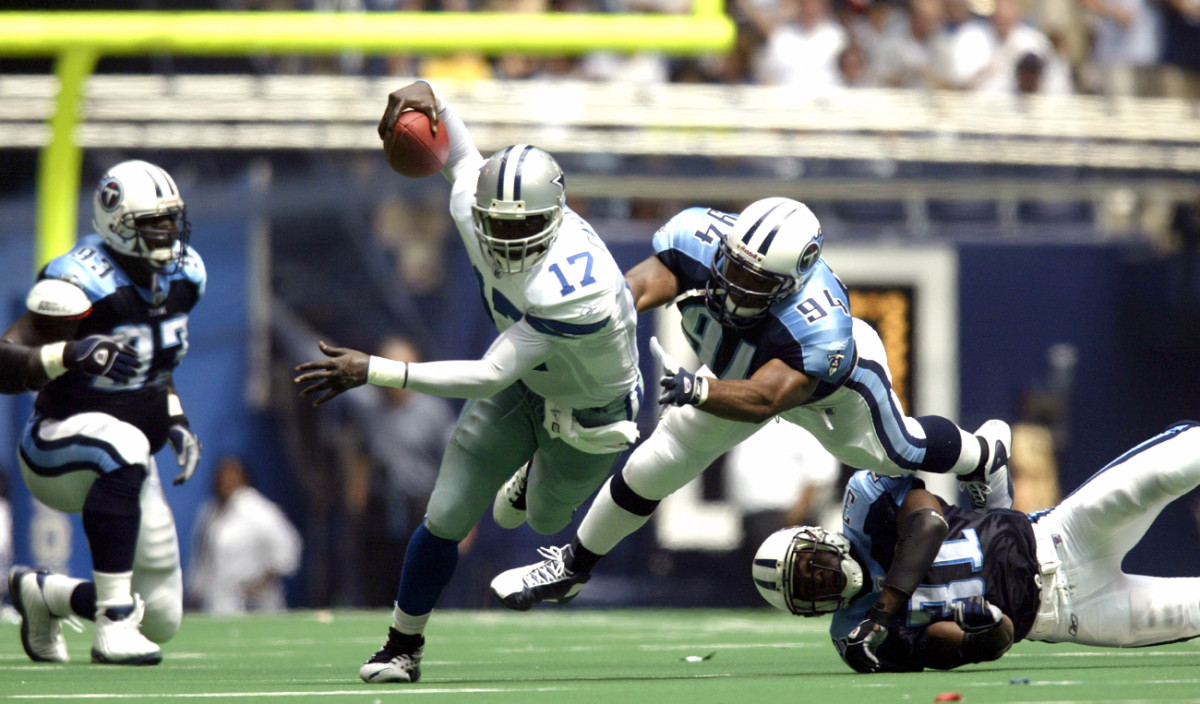
In October 2006, Tony Romo replaced Drew Bledsoe as the team’s starter, leading Dallas to a 6-4 finish. He led the Cowboys to a 13-3 record in 2007, passing for 4,211 yards in his first full season.
BRAD JOHNSON (2007-08): One of the best plays I ever saw [Romo] make: We were playing St. Louis in Dallas [in September 2007]; we were around the 50-yard line, and the ball is snapped over his head in shotgun. He ran back to about the 20-yard line to grab it. Most quarterbacks would fall on the ball or take a knee, which is the smart play to make, but Tony picked it up, and he ran around for 20 yards.
WILSON: He dodged about eight guys and makes it like a three-yard positive play to get the first down. He made so many guys miss, it was unbelievable.
JOHNSON: That was Tony. Tony can make a great play out of something bad.
CARTER: We played some basketball together, and I saw how good an athlete he was. Man, he’s got it all. I think his best attribute is his shooting. He can shoot that rock from anywhere. It hurts me that he couldn’t take the boys over the top. He worked so hard. Shoot, every time I would be in the weight room and look out the damn window, it was like, Goddam, is that dude out there still throwing his ball? I had probably thrown earlier that morning, but then seeing him, it was like, S---, man, I got to back out here and do something!
TONY ROMO (2003-16): I was a little crazy. I was obsessed, to say the least. It really had nothing to do with a work ethic, I just couldn’t sleep at night without the feeling of thinking that I had gotten better physically at throwing the football. I used to go throw the football in the morning in my backyard, and then I would go to football practice, and then I would come back out with David Lee, who was our old quarterbacks coach. I’d wait until everyone was gone and I would go out there, he’d come up and turn the lights on in the facility for me at 10 o’clock at night, and I’d throw 20 footballs. If he couldn’t make it, I would go up on my own and throw into a net with my own 10 balls. Instead of always having to learn on the practice field while the coaches are watching, I got to do it on my own. I feel like that’s what the best quarterbacks do.
The Tony Romo Experiment: Rookie TV Analyst Reflects on First Two Months in CBS Booth
LAUFENBERG (now a Cowboys radio network color analyst): I’ve basically seen every throw the guy has made, including training camp. I go to every practice. I just think he was about as underappreciated a quarterback as there has been in the NFL. Not just Cowboys. He was really, really good. I know it’s a big if, but if this had been a better team around him and they had been a Super Bowl winner, I think there is no doubt he would be in the Hall of Fame. But as it stands, he won’t sniff it.
A back injury to Romo during the 2016 preseason paved the way for fourth-round draft pick Dak Prescott to take over as the Cowboys’ starter in his rookie season.
DAK PRESCOTT (2016-present): Tony was as helpful as I can imagine. Once we scored two touchdowns on back-to-back series opening drives, and then he comes up to me and says, “Hey, be ready for the defensive coordinator to change his whole game plan because you are killing him.” Things like that that I will never forget. Five to 10 years from now I’ll be in a game where we score the first two or three possessions, and I will think about Tony Romo telling me that.
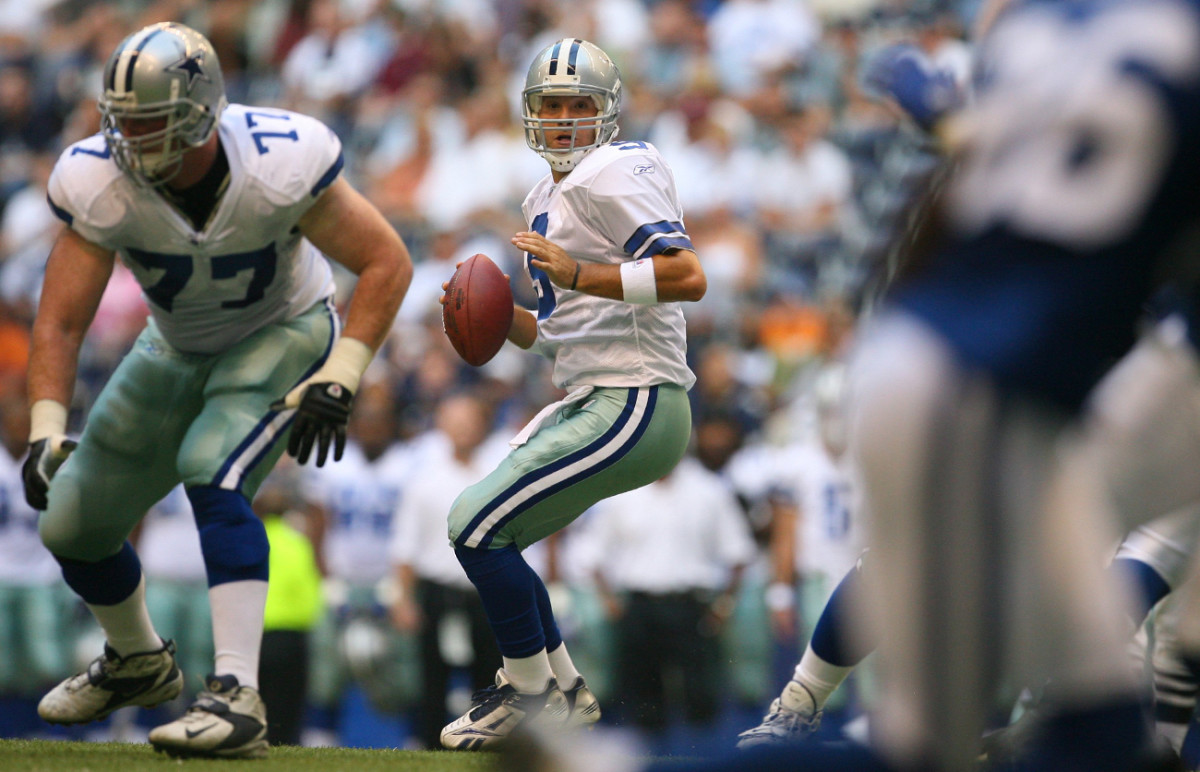
ROMO: It benefits young quarterbacks to be around guys who are good. If they are smart, they will quiz them all the time. It’s like me going into broadcasting right now—if I’m smart, all I’ll do is just wear out the people who have gone before me. The top guys are so good, and there are a lot of little bits of advice that can give you advantages, and you can be ready for things that you shouldn’t be, things that you need to experience first to learn. If you can learn it before you experience it, that’s a huge plus. In some ways it would be better for Dak to see and hear all those things for years. But he soaked it in great, and he’s a smart kid. He’s got a bright future.
WILSON (now the Cowboys quarterbacks coach): It was very difficult [to continue with Dak as the starter, even when Romo had recovered from injury]. I’m trying to coach up Dak because we have a great thing going and had a relationship with Tony. I’d tell him, Stay dialed in, come on, work with me. I understand where you are coming from, but if something happens to Dak, you have to be ready to play. He understood what I was saying, but he didn’t always show that he enjoyed what I was saying.
How the Loss of His Mother Inspired Dak Prescott to Advocate Cancer Education
ROMO: I think you are going to need your whole life, wishing you ... It is obviously a hole on my résumé, but we don’t get to choose when we come about and what time. We all wish we played for the ’92 Cowboys. Peyton Manning had a No. 1 defense, and he wasn’t even playing at a level conducive to what he did his whole career. But when he had that in Denver, they won a Super Bowl. I feel like I can sleep at night knowing that I may have come up short, but I gave everything I possibly could. That’s a special feeling to have that. I just feel like I was one of the lucky ones.
BEING THE BIG MAN IN BIG D
Whether you are Roger Staubach or Brandon Weeden, there’s a moment, sooner or later, when you realize that there’s nothing like being quarterback of the Cowboys—for better or for worse.
LAUFENBERG: One time we had Elizabeth Taylor go out and do the coin flip, she had a new perfume line out, Diamonds or whatever it was called. I’m standing on the sideline, and there is Elizabeth Taylor standing next to me, and she is going out for the coin flip. And I just thought, This is a little different. And to Jerry’s credit, I just thought, O.K., we’re not in Kansas anymore, Dorothy.
KEVIN SWEENEY (1987-88): When I got home from the Giants game [Sweeney started the second half in place of Pelluer and passed for three touchdowns in the 1988 loss], there were five TV trucks at my house. My wife was waiting for me and so were the reporters. It was chaos. It was a week of chaos for that. People kept knocking on the door. People lined up there. I went to [passing game coordinator] Paul Hackett’s son’s playoff game at Southlake. I got caught at that game, and I ended up signing autographs for three and a half quarters until I went down to present the trophy. That doesn’t happen very many places that I’m aware of. At least for me, growing up in California, that is not quite like that.
DREW BLEDSOE (2005-06): Walking down the tunnel in the old Texas Stadium, that was a pretty cool scene. As I was coming out, I really did make a conscious effort to enjoy everything that I was doing. I would generally grab a rookie by the back of his shoulder pads and get in his ear and say, “Man, how f------ cool is this, that we get to go do this for a living? Let’s go have fun!”
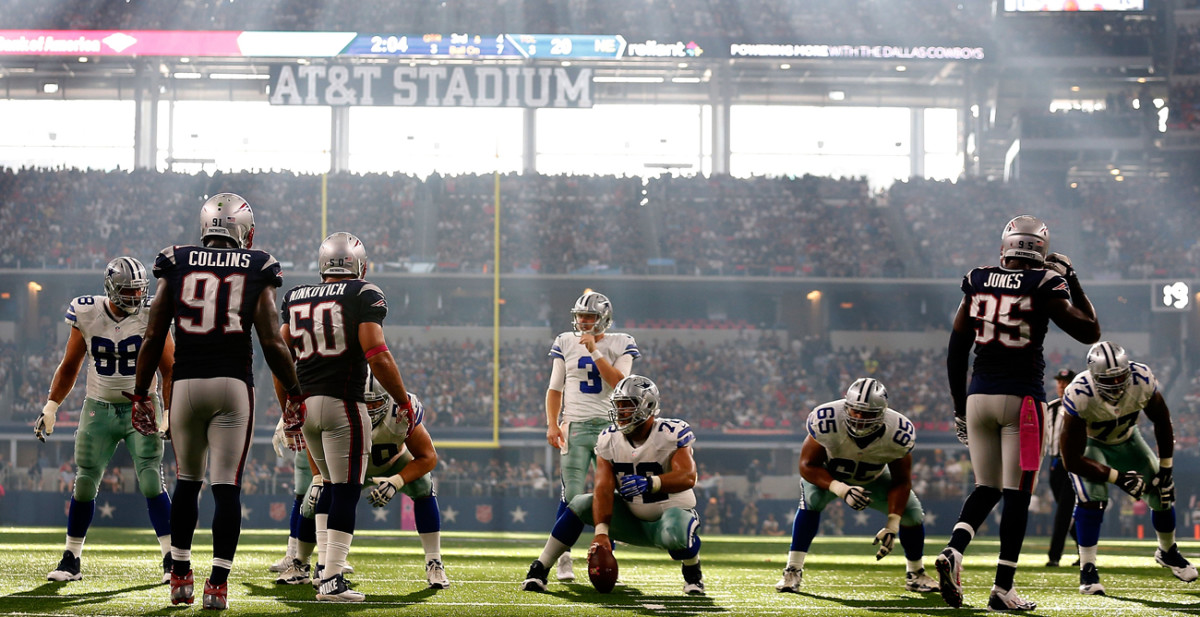
JON KITNA (2010-11): The craziest thing to understand is just the passion that people have for the Cowboys. My first training camp, you show up and you go to the opening night, this is just the players showing up. Well, there are 25,000 people there to just see you walk in. That’s not normal. It’s not like that everywhere.
BLEDSOE: It’s kind of like pitching for the Yankees. You’re that guy. Nobody is ambivalent about the Cowboys. People either love them or hate them. It was really kind of funny, a lot of my close friends are Niners fans, and it was really hard for them when I was playing for the Cowboys.
AIKMAN: The quarterback for Dallas is given a lot of attention every season. That’s what separates him from the quarterback in Jacksonville. Having said that, I don’t think the pressure is any greater in Dallas than it is in Jacksonville. I really don’t. There’s more attention, more discussion, but there’s pressure on all 32—the same pressure. The money’s great everywhere. The pressure to win, I believe, is the same on all the quarterbacks, all the coaches, all the GMs. They have to win. If they don’t feel it, they shouldn’t be playing. There’s a vast difference between attention and pressure. For me, I don’t think there was ever a time that it was overwhelming.
BRANDON WEEDEN (2014-15): The perception from the outside looking in, the lights are brighter. And after playing there for a couple years, the lights are brighter. Every Thursday night, me, Tony, Jason [Witten], DeMarco [Murray] and sometimes Dez [Bryant] would go to dinner at Nick & Sam’s, that was our ritual. When you go out in public, and you see the way people treat him, and I know it’s Tony Romo, but you see his celebrity-type status, and you think, O.K., this is a bigger deal. People bleed blue and silver. Coming from Cleveland [and the Browns], I had never been around another quarterback like that.
ROMO: You wouldn’t be human if you didn’t recognize the lineage and the history of high-level quarterback play that have been around. I am a football junkie and historian, and obviously I love the Dallas Cowboys. I used to sit around and watch tape of Aikman and Staubach—it was harder to find tape on Staubach, but it was great. You try to find something in their game that you can use to make you better.
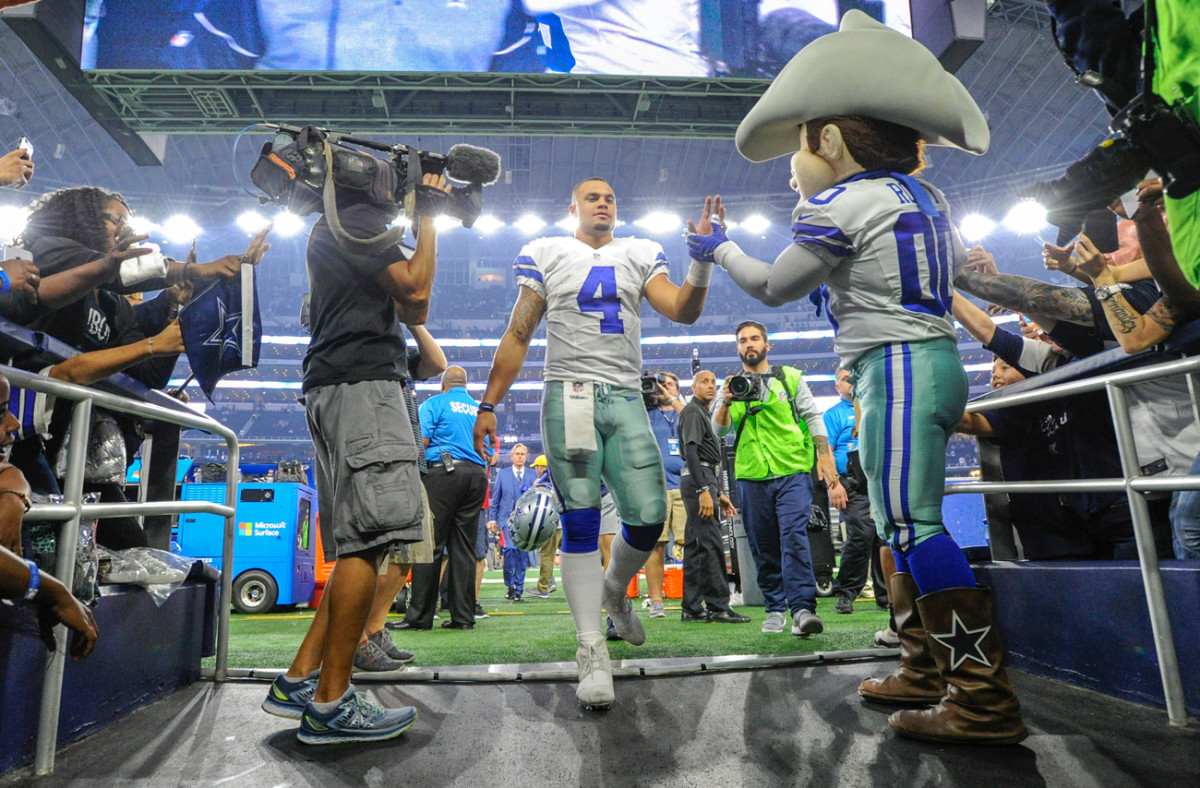
PRESCOTT: You realize quick why it’s America’s Team. Everything that you do is going to be seen and exposed to the world, good or bad. You notice that pretty quick, just how many cameras are at practice, how many media are in the locker room. I know everybody’s got it, but I would say ours is probably a little more than everybody else’s. It hits me when I am all the way across the country, East Coast or West Coast, and people know who I am and are calling my name.
WHITE: My favorite picture on the wall in my office is a picture of me and Troy and Roger and Craig and Don and Eddie [LeBaron, the first QB of the Cowboys] and Coach Landry. Landry drafted Troy—it wasn’t Jimmy Johnson—so we considered Troy to be one of us. We just happened to all be at a golf tournament together. It was the only time that all seven of us had been in one place at one time. I love that photo. That’s a real honor, to be one of Landry’s quarterbacks. It’s like being one of Lombardi’s quarterbacks. There just weren’t very many of them. To be a Dallas Cowboys quarterback is something that we’re all very proud of.
From The Cowboys QBs, a special issue of Sports Illustrated. To order, click here.
Question or comment? Email us at talkback@themmqb.com.
